
Newsletter of the Shell Club of Sydney
NSW Branch, The Malacological Society of Australasia Limited ACN 067 894 848
Man & Mollusc Web Site
http://www.manandmollusc.net/
Site by Avril Bourquin
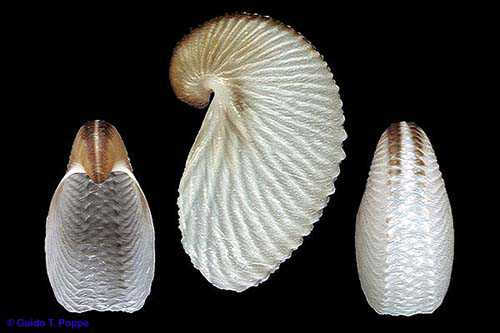
Argonauta nouryi Lorois, 1852
Photo Courtesy of Guido Poppe from Man & Mollusc web site
This web site does not yet have many graphics, but it contains well written information targeted at varying age ranges. (See picture front cover)
One interesting section describes the correct process of identifying and naming a new species, for those that wish to do this themselves.
Another extensive section is about amazing Molluscan facts.
The text is comprehensive enough to educate but not confuse the reader. Unfortunately it does not lend itself to including a short excerpt, so I have included the following complete single page from the site, as follows:
The Phylum Mollusca
(an Introduction, for High-school level students, and all others interested!!)
Early Beginnings:
The time is now about 600 million years ago and the first molluscs have made their appearance on our world. About 100 million years later, during the Ordovician period, at least six of the seven classes of molluscs represented today were present. Many of these first molluscs were but simple, worm-like animals, having segments similar to what we find in annelid worms and arthropods. These first molluscs crawled about the primeval seas, probing for and eating microscopic bits of food.
The great landmass of Pangaea slowly deposits dissolved salts and other chemicals into the ocean. The first primitive molluscs in these oceans now digest these chemicals and begin to use the nutrients to build themselves protective shelters (shells) against their hostile environment. As Pangaea breaks apart around 200 million years ago, the world's great continents slowly migrate, due to plate tectonics, and we begin to recognize the world continents as they are today.
Over time, the molluscs flourish and evolve to fit newly developing habitats. Fossil records show some groups ("taxa") growing larger, some smaller. Some grow spiny, others, shiny. Some coil tighter, some looser. Some coil left to right while others loose their coil all together. Some even loose their shells completely. Some, like the ammonids, evolve into huge numbers of species, and then mysteriously disappear forever only to be found as fossils. //About 400 Million years ago, some of these molluscs, first the bivalves, begin to inhabit the worlds freshwater streams and lakes. It took at least another 300 million years for certain gastropods to evolve to where they were capable of populating all land and freshwater water habitats.
During the last million years, the land and freshwater molluscs have evolved very rapidly; however, some groups of marine molluscs appear to be decreasing in the number of species existing.
Today, molluscs live in almost all parts of the world. From the deepest ocean trenches to high up on our mountains, molluscs have found their niche. The number of living species ranges from a very conservative 50,000 according to Brusca & Brusca (Invertebrates 1990) to 60,00 in Rupert & Barnes Invertebrate Zoology (sixth edition 1994) to 100,000 in Kozloff's Invertebrates (1990). That said, it is quite likely that up to half a million species will eventually be formally discovered (see the web pages on How to name a Species, for how this is done!), since many environments and the deeper parts of the sea-floor are very poorly known even today!
Classification and taxonomy of molluscs can vary widely depending on what school of though you prefer or the source you read.
One thing does remain constant in all molluscs however - to survive all molluscs must have moisture. To stay alive, they must keep their soft bodies moist at all times and for some like those which live in hot dry deserts environments, this is done by curling up in their shell, secreting a mucous plug and staying holed up until the next bit of moisture comes along.
What is a Mollusc?
The word "mollusc" or "mollusk" (both are correct) is derived from the Latin word mollis meaning "soft". The study of molluscs, "malacology", comes from the Greek word for soft, malacos. The term "conchology" is also used for the study of molluscs; however, it is usually applied to those that study the shell only.
Molluscs, in general, are soft-bodied animals that usually produce an external skeleton (called an "exoskeleton") we call a Shell, which is composed of a limey material: calcium carbonate (CaCO3) The shell serves both protective, and supportive purposes. The one feature common to all molluscs is the presence of a fleshy mantle. This is a fold or lobe (or a pair of them) of fleshy material, which secretes, modifies and lines the shell. Members of all classes except the bivalves possess a ribbon-like set of hooked teeth called radula. These they rasp (think of a fingernail file) back and forth over their food much the same idea as a cat lapping up milk: vegetarian species use them to scrape algae off rocks and other substrates, while most molluscan carnivores use them to penetrate the surface of their prey - even when that is a decent thickness of shell! In the superfamily Conoidea, which includes the Cones and the largest family in the mollusc world, the Turridae, the radula is specialized into a form of miniature "harpoon", which is used to spear prey, and in many cases, to deliver powerful neurotoxins, to paralyze their hapless victims. Most molluscs have a well-defined nervous system with a primitive brain. Molluscs have a circulatory system and most have a two-chambered heart. Their digestive system usually includes a jaw, pharynx, esophagus, stomach, intestine and anus. They have a reproductive system that produces eggs and/or sperm. Most gastropods and cephalopods have eyes and tentacles.
The molluscs we recognize today are divided into seven divisions called "classes".
Let us take a very brief look at these classes now:
The POLYPLACOPHORA contain about 900 living species and are commonly known as chitons. They have a shell consisting of eight, usually overlapping plates, held together by a leathery "girdle". The animal is bilaterally symmetrical. With a well-developed foot surrounded by a groove in which there are 6 to 88 pairs of gills. The head lacks eyes and tentacles, but usually has light-sensitive areas and chemical receptors, for finding food and heading in the proper direction! All chitons are marine inhabitants and most make a living by grazing algae from rocks and other hard substrates. The great majority of them dwell in shallow and intertidal waters, but a few occur in depths down to 5,000+ meters. They range in length from 3 to 400+ millimeters. (1/8" to 1ft 4"+).
The APLACOPHORA consist of about 250 living species (perhaps more, as they are relatively poorly studied!) of marine, wormlike, bilaterally symmetrical animals living at moderate, to very great depths, usually on or in soft bottoms. They have no shell, but have calcareous spicules in the body surface. The foot is restricted to an anterior pedal shield or to a narrow groove running the length of the body. Aplacophorans have a radula and a posterior mantle cavity. Some are detritus feeders, others are predators. They range in length from 1 to 300 millimeters.
(If you read and go along with the views held by Brusca & Brusca (see bibliography) you will also include the Class of Caudofoveata and Solenogastres. These are two very small classes that many scientists combine to form the Class Aplacophora. The Caudofoveata are aberrant molluscs that lack shells. They are quite common in the deep sea buried in the soft sediments. The Solenogastres also lack shells, are also found in very deep water and generally live on the surface of the substratum.)
The SCAPHOPODA comprise about 350 living species. Commonly known as "tusk shells", they are bilaterally symmetrical and their elongate, tubular, tapering shells are open at both ends. The conical foot can be protruded for use in burrowing only. The head is rudimentary and lacks eyes and tentacles. It feeds by contractile filaments called captacula, which are withdrawn into the body cavity when they meet up with food. All scaphopoda are marine, and live buried in muddy or sandy bottoms, where they feed on detritus. They range from 2 to 150 millimeters (i.e., up to 6").
The CEPHALOPODA contain about 600 to 650 living species. This class includes octopus, squid, cuttlefish and nautilus. They are bilaterally symmetrical and often highly streamlined. Tentacles surround the head, and a funnel coming from the mantle produces jet propulsion. Only a few cephalopoda produce a calcareous shell. They have an advanced nervous system and are the most intelligent of all the invertebrates. All are marine inhabitants and are predators or scavengers. They range in size from 10 millimeters to 20 meters for the giant squid.
The class GASTROPODA is by far the most successful of all the molluscs, with at least 60,000 living species. Gastropods generally have a single-valved shell, which is usually spiraled; however, this is absent in the slugs and semi-slugs. They have a head with cephalic tentacles and a well-developed foot used in crawling. Some gastropods have lungs for respiration, others gills. Early in their larval stage of development, the visceral mass and mantle cavity rotate up to 180 degrees counterclockwise; in a process know as torsion. (This does not occur in some of the slugs though.) This brings their organs from a posterior position to an anterior position behind their head. In most cases, the soft animal is able to retract into their shells for protection. Some gastropods also have an operculum (trap door) connected to their foot that they can pull in after their soft body parts sealing off their shell from the environmental hazards or as protection from enemies. Gastropods are very successful in marine, freshwater and terrestrial habitats. Their size is from 0.5 to 750 millimeters. (i.e., up to 2 1/2 feet long)
The BIVALVA, or PELECYPODA (the Bivalves) comprise about 10,000 living species. They have two valves made of calcium carbonate (in a hard form called "aragonite"), connected by a flexible ligament and an "adductor muscle" for closing the valves tightly. The mantle cavity is enlarged, enclosing the visceral mass and other internal organs. There is no differentiated head or cephalic region, and the radula common to all other molluscs is absent. Most are filter feeders, with the gill acting as a food collecting and sorting organ, in addition to filling its respiratory function. The mouth usually has a pair of labial palps on either side that handle and direct the food collected by their gills. Bivalves inhabit all of the world's marine and freshwater habitats which have a pH greater than about 5 - any more acidic than that, and they can't form a shell fast enough to prevent it from being dissolved again! They range in size from 0.5 millimeters to almost 1.4 meters (that's 1400mm, or 4'8"!!)
MONOPLACOPHORA are mostly are known by their fossil records; however, there are about a dozen living species today. They have several foot retractor muscles, gills, and hearts similar to those of the annelid worms; however, their bodies are not segmented. All Monoplacophorans are marine inhabitants grazing on algae and microorganisms on the hard ocean bottom. They live at depths of 200 to 6,000 meters and they range in size from 2 to 35 millimeters.
Now Let's Take a More Detailed Look at The Phylum Mollusca
A phylum is usually defined as group of animals having several features common to all or most of its members. The following features are common amongst most molluscs:
A mantle that secretes calcium carbonate in the form of spicules or shell
A mantle cavity where respiration occurs, usually through the ctenidium (gill) in aquatic forms, or through the mantle wall in terrestrial molluscs. This is also where excretory and reproductive organs discharge as well.
A body divided into three regions, the head, foot, and visceral mass
A radula, which is a ribbon of teeth used in feeding
Three coelomic (body cavity) spaces, for kidney, heart and gonad
A Foot used in locomotion and often for digging into the sand or mud bottom where many live.
Biologists use various methods for estimating how closely species are related to each other. They look at comparative anatomy, genetics and paleontology (the study of fossil organisms) to help form their theories. Changes within a population (a group of organisms of one species) generally occur due to divergence and speciation.
Divergence within a phylum can occur whenever the population is split into two or more groups with no chance of interbreeding. Divergence is generally brought about by such events as habitat changes or competition for food.
Speciation can result from reproductive isolation (populations can be physically isolated, as in many marine species, without being isolated reproductively, due to larval (veliger) stages which can drift for long distances, thus effectively "connecting" geographically remote populations. On the other hand, behavioral, morphological or reproductive differences in a small segment of a population can gradually lead to reproductive isolation, without much physical segregation. These reproductively separated populations will adapt to different conditions in different regions, via "natural selection" (i.e., survival of the fittest!). They may develop different mating behaviors or breeding seasons, or they may accumulate enough genetic differences to render egg and sperm incompatible. It is due to an accumulation of these changes and other morphological and genetic differences that we have the seven classes of molluscs today. This seemingly advanced degree of differentiation, however, took place hundreds of millions of years ago: by the middle of the Ordovician period, all the shell-bearing classes (6) of mollusc are represented in the fossil record.
Now, lets take a closer look at these seven classes of molluscs. We'll cover the basic anatomy and physiology and behavior of each group, and a variety of other interesting facts about each. Enjoy!!
The two first two classes we will discuss - the Aplacophoran and the Polyplacophoran, are often regarded by some as Subclasses of a larger Class called Amphineura (Amphineura: (am-phi-neur-a) Latin: amphi =both . neura =nerve). However, we will follow the crowd (i.e., the majority of scientists), and treat them separately.
These are the clickable links on the actual site, go to http://www.manandmollusc.net/
POLYPLACOPHORA
APLACOPHORA
SCAPHOPODA
GASTROPODA
BIVALVA, or PELECYPODA
CEPHALOPODA
MONOPLACOPHORA
References used
(Internet Sites, as well as good, old-fashioned books)
Rodd Island Sydney Harbour
51' 49" S, 151 09' 09" E
By Michael Keats & Stephanie Clark
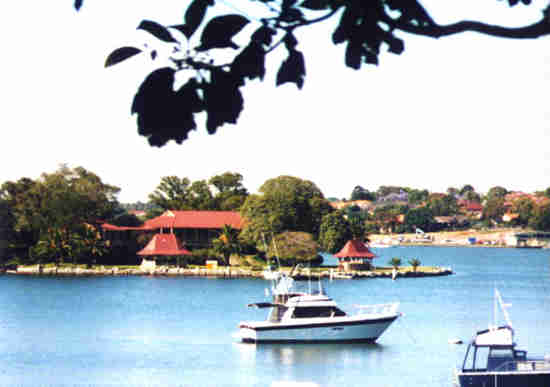
Rodd Island is centrally located in Iron Cove in the upper reaches of the Parramatta River. It is about 13 kilometres west of the entrance of Sydney Harbour. It is today, almost 50% larger than when first sighted by Captain Hunter and his crew in 1788. The rich sand flats surrounding the sandstone island observed by Captain Hunter have now been reclaimed.
The history of the Island is complex and bizarre. Its various uses since 1788 include a quarantine station, boat building yard, Edwardian picnic venue, haven for drug users, conference centre and National Park make for a fascinating visit. The successive uses also placed pressures on the mollusc fauna that is today significantly reduced.
The association between shell collecting and Rodd Island arguably commenced in 1842, when on January 1st Mr B. C. Rodd, a significant landowner in the area wrote to the Colonial Secretary the following request.
"Sir, I request permission to purchase a small island in Iron Cove Bay, nearly opposite Iron Cove Bay Point (Rodd Point), containing about 1 acre.
"The land is of little value, and my principal object in purchasing it would be to prevent squatters or rather shell - gatherers, from taking up their abode there occasionally, and thereby becoming a great nuisance to me.
For Rodd Island to be a haven for "shell - gatherers" it must have supported a significant mollusc population. Imagining the island in pristine condition with zostra?? weed beds and extensive sand flats exposed at low tide it is possible to build a picture of shell gatherers collecting.
We know from long dead specimens recently collected from around the shore of Iron Cove that the fauna was a diverse one. Large quantities of
Anadara trapezia, Anomia descripta, Ostrea angasi, and Tapes dorsatus would have been gathered and transported by boat for sale at the fish markets of Sydney town.
Large Pinna species, various Venerid, Mactrid, Cardium and Naticids would have made the island the shell Mecca described in 1842.
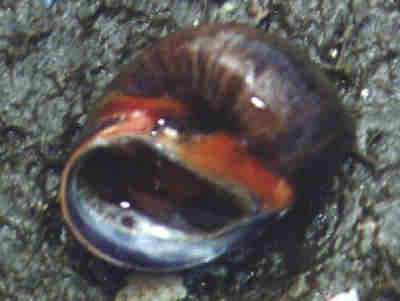
Polinices sordidus
From Children's swimming area

Stephanie, weed washing southern end
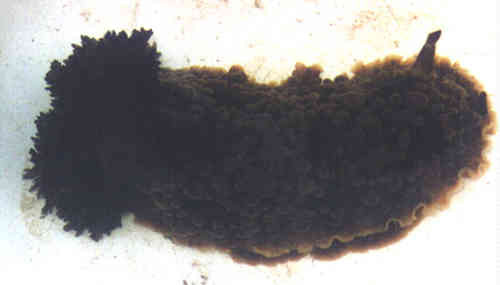

Dendrodoris fumatus
Northern beach
The clear streams flowing into the upper reaches of Iron Cove would have been unpolluted back then and fringed with large stands of mangroves that would have supported a diverse fauna. Even today the remaining patches of mangroves still support a number of species.
Today, these once pristine streams are the polluted concrete lined storm water channels of Timbrell Park and the Hawthorn Canal. In 1842 they would have been healthy nurseries for fish and crustaceans. Today they appear to be slowly coming back.
The visit to Rodd Island on 22/11/1999 by Michael Keats and Stephanie Clark was to a very different world to that which inspired B. C. Rodd to complain about "shell gathers" in 1842. The setting is still tranquil enough. Boarding the National Parks & Wildlife Service boat at the Thompson Street wharf, Drummoyne, it was a 5 minute trip to the island wharf and the plaques recognizing the role of Beresford Rodd in the settlement of the area.
As you approach the island, the built environment is dominated by "the conference centre / boat shed / house complex" and the serendipity of the Edwardian picnic shelters. The sandstone sea wall gives the island a somewhat "just landed" appearance.
During the short trip ranger Ben was busy pointing out the features of his quixotic abode that today provides a remarkable Noah's Ark for so many birds and insects. It was not always the case. When he arrived some 8 years earlier the dominant wildlife was rats followed closely by drug addicts!
Where there was once rubbish and broken glass there is now deep humus and thriving native plants. These are matched as closely as possible to the described original vegetation. The island has been heavily planted with exotic species that are progressively being replaced with native species. Ben says he is amazed at the speed of recolonisation by native birds and insects and the diversity of life that has returned.
This brought us to the all-important issue of the marine fauna. After some very welcome hospitality delivered by Dora, Ben's wife, we were conducted around the island at shore level. The 2 best "beaches" for shells are the old slipway (an artificial beach at the southern end) and the Edwardian children's swimming area on the north east corner.
The largest "beach area" is on the northern end. This area is similar to some of the surrounding sand/ mud flats present in Iron Cove. It is now enclosed with a sandstone wall and designated as a swimming area. Unfortunately the beach was well coated with mud but still supports live Tellinids, Naticids, Cerethids, Crustaceans and Nudibranchs.
Ben commented on the rapid growth of a sargasum seaweed which he had noticed in the last 3 months. He also said that the rise of the population of
Mytilus plannulatus Lamarck, 1822 over the last 18 months had been remarkable.
The tide was 0.2 m and we started at the old slipway. The only living taxa present were
Saccostrea glommerata, Bembicium aurantum and Bediva hanleyi
and the nudibranchs Noumea haliconea and Dendrodoris densoni on and under rocks.
However a number of species were only found dead including Andara trapezia, Anomia trigonopsis, Spisula Trigonella, Irus crenatus, Cacozeliana grania, Caltholotia fragumand Nassarius. However these taxa are still present today.
In addition some long dead specimens of Siphonaria diemensis, Pupa fumata and
Paracingula brazeri were also found.
In the rock pools immediately above high water were colonies of the introduced New Zealand species,
Zeacumantis subcarinatus
The large beach area supported several living species including, Mytilus hirsuitus, Polinicies sordidus, Bedeva hanleyi, Velacumantis
australis, Nassarius, fresh dead Tellina species and a single specimen of
Aplysia extraordinaria.
Species seen dead only include Circe scripta, Eumarcia fumigata, Soletellina donacoides, Laturnula creccina, Xenostrobus securis
and Corbula stolata of which most are still living nearby
Egg capsules of Bedeva hanleyi were found under rocks and the egg strings of Dendrodoris densoni
were found mostly attached to the sides of rocks.
An unusual man made feature on the island is the Grotto. This semi cave, located under the northern end of the "conference " centre has a supporting column which features a decoration of tropical corals and 5 large specimens of
Trochus niloticus. There is no explanation of why the column was built, when it is was built, who built it or how the tropical corals and shells came to be used. Given the quirky history of the Island anything is possible.
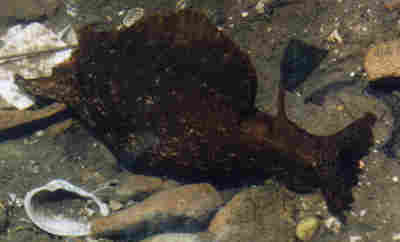
Aplysia extraordinaria Northern beach
|







